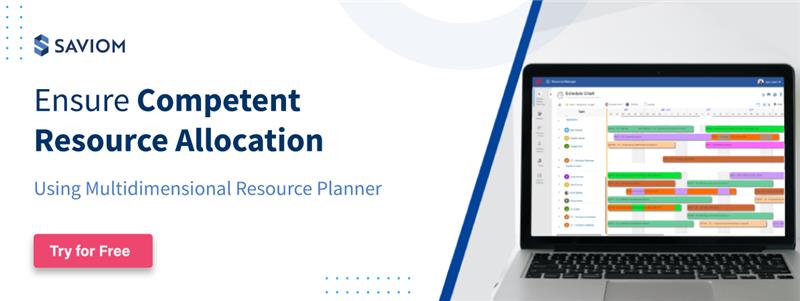Resources are a significant investment for most businesses. Therefore, organizations strive to utilize them optimally for profitability and sustainability. However, managers often focus on keeping resources occupied with work and assign tasks without considering employee skills or interests.
This improper resource allocation blows up costs, delays delivery, and ultimately derails projects off their tracks.
According to PMI’s 2017 pulse survey, “43% of projects spike the budget, and 49% cannot adhere to deadlines.” The study also reveals that only 26% of organizations use resource management for successful resource allocation.”
Resource allocation is an essential step in the resource planning process, and an efficient resource management system helps achieve the same. This article will cover the concept, challenges, importance, and successful resource allocation methods.
1. Definition of resource allocation:
Resource allocation, also known as resource scheduling, recognizes and assigns resources for a specific period to various activities. These activities can be either project or non-project work such as BAU, admin, support, operation, etc.
Assigning 100% of their capacity ensures maximum utilization of resources.
Resources can be either fully or partially available. Therefore, resource managers must take resource availability into account while allocating them to the projects.
2. What are the challenges of resource allocation?
Resource allocation is often easier said than done. Without the right tools or techniques in place, identifying the right resource can be a daunting task. Let’s have a look at some of the resource allocation challenges:
2.1 Change in project scope:
Despite taking necessary control measures, the project scope can still change anytime during the project lifecycle. In addition, changes in Project requirements in an agile world can lead to fluctuating resource demands. So, without an up-to-date resource schedule, frequent allocations to meet the changing needs become incredibly challenging.
2.2 Use of outdated legacy tools:
Spreadsheets and homegrown tools are inadequate for resource allocation. They fail to provide real-time updates in project/resource schedules, causing discrepancies and redundancies. It can lead to double booking chaos that dampens the project’s success.
2.3 Miscommunication between sales and delivery team:
While focusing on achieving sales targets, sometimes the sales team doesn’t involve the delivery team before signing the deal. As a result, the delivery team ends up scrambling for resource allocations at the eleventh hour to meet the delivery deadline.
2.4 Lack of resources visibility within a matrix organization:
Not having a centralized resource planner means there is no visibility of resources and allocations across matrix boundaries. Hence, resource managers find it extremely challenging to allocate the best-suited and cost-effective workforce to the project.
2.5 Mismatch in the skillset between capacity and demand:
The inability to forecast future pipeline project requirements prohibits identifying skill shortages in advance. This incorrect estimation of capacity vs. demand hinders the resource allocation process.
3. What are the benefits of resource allocation in project management?
Resource allocation is essential in project management as it allows you to plan and prepare for project implementation or achieving goals. In addition, it helps schedule resources in advance and provides an insight into the project team’s progress.
Resource allocation is much more than just delegating assignments. It plays a vital role in project and operations management and eventually improves business performance. It also helps achieve optimum utilization and enhances ROI.
Here are some key benefits of resource allocation in project management:
i) Reduce project resource costs significantly
ii) Maximize the productivity of resources on projects
iii) Enhance employee engagement and satisfaction
iv) Facilitate client satisfaction with successful project delivery
v) Achieve the best outcome within existing resource constraints
4. Best resource allocation methods for successful businesses
Now that we know how resource allocation helps in successful project delivery, let’s take a look at some of the best resource allocation methods:
4.1 Identify and allocate the Best-Visible-Best-Fit resources:
A Resource management system consolidates resource data from various systems into a centralized platform. Complete visibility helps assign resources to the project based on skills, qualifications, experience, availability, costs, and other selection criteria. Scheduling cost-effective global resources from low-cost locations maintains profitability without compromising quality.
One of the methods of resource allocation is assigning best-visible-best-fit instead of first-available-first-fit resources. Visibility also allows uniform distribution of skilled resources across multiple projects instead of only deploying them to a high-priority project.
4.2 Avoid under or overallocation of resources:
Uniform distribution of resources across all projects ensures that no employee is under or overallocated with work. Underallocation of resources results in productivity and revenue loss. Conversely, overallocation can cause burnout, affect the quality of output, or, worst, result in unplanned attrition.
Forecasting billable /strategic utilization helps project managers to move resources periodically from non-billable to billable/strategic work. Thus, it facilitates optimum resource utilization and improves business efficiency.
4.3 Subscribe to an automated resource request process:
While allocating resources, manually sifting through the resource pool or taking phone/email requests from individual project managers can be cumbersome. An automated resource requesting that is independent of cumbersome spreadsheets streamlines the process.
It allows project managers to specify the required skill sets, qualifications, experience, cost, and project timelines. This request directly reaches the inbox of the resource manager in charge, who starts planning for the same. As the entire process is documented and auditable, tracking allocation records eliminates any process-related confusion.
4.4 Empower employees to work on projects of interest:
Studies have shown that when employees work on tasks of their choice, it has a positive effect on their engagement and productivity. Therefore, managers must also consider their interests instead of allocating resources only based on their skills and availability. To achieve this, resource managers can create open positions and publish the same, which becomes visible to all the relevant personnel across the enterprise.
Accordingly, interested resources can show their interest in joining the project, and the concerned resource manager can select the appropriate project team. It also saves the resource manager’s time from looking across the enterprise to find the right fit and negotiating with their line/ project managers. Therefore, this method is a win-win for both resources and the managers responsible for their allocation.
4.5 Diversify employee skill sets and responsibilities:
Encourage employees to have at least two or more skills. Allocating resources on projects that need various skills allows them to sharpen their primary skill sets and an opportunity to build new ones. They can also be given further training on acquired skills, and on-the-job experience helps them improve their capabilities.
Sometimes, when employees get roll-off from a project, there isn’t any task to assign them based on their primary skills. Here, their secondary skill sets will come in handy, and they can be made billable by allocating them to other projects.
Sometimes, the demand for a niche skillset to start a new project may arise. As these resources are hard to find, out-rotating a niche resource from an ongoing project helps kickstart the new project. Simultaneously, another resource having minimum qualifications can backfill to continue the current project. This dynamic resource allocation ensures that none of the projects suffer.
4.6 What-if analysis to fulfill dynamic project demands:
Juggling resources within multiple projects is common when resources are limited. However, in this ever-evolving business environment, any error from poor judgment can prove to be very costly. So it is when the simulation of business scenarios comes in handy.
Applying different sets of rules on the same resource pool and comparing situations can help visualize various impacts. For example, it can involve stalling or extending the low priority project’s timeline and allocating its available resources to a high priority one.
What-if analysis, a powerful feature of resource modeling and simulation, helps arrive at potential outcomes using constraint-based assessment. Like weighing the pros and cons of options in our everyday situation, this principle applies to resource planning and allocation. Once the ideal and feasible scenario is derived, implementing the same on an actual project schedule facilitates successful resource allocation.
4.7 Use real-time Business intelligence to monitor and improve resource allocation
Even after the resource allocation process is complete, there can be changes in the project requirement that requires immediate attention. Modern resource management solutions equipped with real-time business intelligence dashboards and reports help improve the enterprise’s health index.
Role-based customizable dashboards enable decision-makers to make informed decisions and make adjustments to the resource allocations accordingly. Thus, real-time business intelligence help in tracking and controlling resource allocations ahead of time.
5. The Glossary
6. The Saviom Solution
SAVIOM is the market leader in offering the most powerful and configurable solutions for deploying appropriate resources to suitable projects. With over 20 years of experience, this Australia-based MNC has helped more than 100 clients across over 50 countries address specific business challenges. SAVIOM also provides tools for project portfolio management, professional service automation, and workforce planning software.















